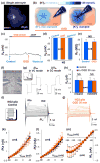Dissipation of transmembrane potassium gradient is the main cause of cerebral ischemia-induced depolarization in astrocytes and neurons
- PMID: 29407729
- PMCID: PMC5864540
- DOI: 10.1016/j.expneurol.2018.01.019
Dissipation of transmembrane potassium gradient is the main cause of cerebral ischemia-induced depolarization in astrocytes and neurons
Abstract
Membrane potential (VM) depolarization occurs immediately following cerebral ischemia and is devastating for the astrocyte homeostasis and neuronal signaling. Previously, an excessive release of extracellular K+ and glutamate has been shown to underlie an ischemia-induced VM depolarization. Ischemic insults should impair membrane ion channels and disrupt the physiological ion gradients. However, their respective contribution to ischemia-induced neuronal and glial depolarization and loss of neuronal excitability are unanswered questions. A short-term oxygen-glucose deprivation (OGD) was used for the purpose of examining the acute effect of ischemic conditions on ion channel activity and physiological K+ gradient in neurons and glial cells. We show that a 30 min OGD treatment exerted no measurable damage to the function of membrane ion channels in neurons, astrocytes, and NG2 glia. As a result of the resilience of membrane ion channels, neuronal spikes last twice as long as our previously reported 15 min time window. In the electrophysiological analysis, a 30 min OGD-induced dissipation of transmembrane K+ gradient contributed differently in brain cell depolarization: severe in astrocytes and neurons, and undetectable in NG2 glia. The discrete cellular responses to OGD corresponded to a total loss of 69% of the intracellular K+ contents in hippocampal slices as measured by Inductively Coupled Plasma Mass Spectrometry (ICP-MS). A major brain cell depolarization mechanism identified here is important for our understanding of cerebral ischemia pathology. Additionally, further understanding of the resilient response of NG2 glia to ischemia-induced intracellular K+ loss and depolarization should facilitate the development of future stroke therapy.
Keywords: Astrocytes; Brain ischemia; Ion channel; NG2 glia; Neurons.
Copyright © 2018 Elsevier Inc. All rights reserved.
Conflict of interest statement
None.
Figures







Similar articles
-
Oxygen and glucose deprivation-induced changes in astrocyte membrane potential and their underlying mechanisms in acute rat hippocampal slices.J Cereb Blood Flow Metab. 2008 Mar;28(3):456-67. doi: 10.1038/sj.jcbfm.9600545. Epub 2007 Aug 22. J Cereb Blood Flow Metab. 2008. PMID: 17713462
-
Acute sensitivity of astrocytes in the Substantia Nigra to oxygen and glucose deprivation (OGD) compared with hippocampal astrocytes in brain slices.Neurosci Lett. 2018 Oct 15;685:137-143. doi: 10.1016/j.neulet.2018.08.033. Epub 2018 Aug 25. Neurosci Lett. 2018. PMID: 30153493
-
Kir4.1 channels mediate a depolarization of hippocampal astrocytes under hyperammonemic conditions in situ.Glia. 2012 May;60(6):965-78. doi: 10.1002/glia.22328. Epub 2012 Mar 19. Glia. 2012. PMID: 22431254
-
NG2-glia, More Than Progenitor Cells.Adv Exp Med Biol. 2016;949:27-45. doi: 10.1007/978-3-319-40764-7_2. Adv Exp Med Biol. 2016. PMID: 27714683 Review.
-
On the electrical passivity of astrocyte potassium conductance.J Neurophysiol. 2021 Oct 1;126(4):1403-1419. doi: 10.1152/jn.00330.2021. Epub 2021 Sep 15. J Neurophysiol. 2021. PMID: 34525325 Free PMC article. Review.
Cited by
-
Changes in Astroglial K+ upon Brief Periods of Energy Deprivation in the Mouse Neocortex.Int J Mol Sci. 2022 Apr 27;23(9):4836. doi: 10.3390/ijms23094836. Int J Mol Sci. 2022. PMID: 35563238 Free PMC article.
-
Astrocyte syncytium: a functional reticular system in the brain.Neural Regen Res. 2019 Apr;14(4):595-596. doi: 10.4103/1673-5374.247462. Neural Regen Res. 2019. PMID: 30632498 Free PMC article. No abstract available.
-
Enhanced Response of ZnO Nanorod-Based Flexible MEAs for Recording Ischemia-Induced Neural Activity in Acute Brain Slices.Nanomaterials (Basel). 2025 Jul 30;15(15):1173. doi: 10.3390/nano15151173. Nanomaterials (Basel). 2025. PMID: 40801712 Free PMC article.
-
ALS-like pathology diminishes swelling of spinal astrocytes in the SOD1 animal model.Front Cell Neurosci. 2024 Oct 10;18:1472374. doi: 10.3389/fncel.2024.1472374. eCollection 2024. Front Cell Neurosci. 2024. PMID: 39449756 Free PMC article.
-
Early Reperfusion Following Ischemic Stroke Provides Beneficial Effects, Even After Lethal Ischemia with Mature Neural Cell Death.Cells. 2020 Jun 1;9(6):1374. doi: 10.3390/cells9061374. Cells. 2020. PMID: 32492968 Free PMC article.
References
-
- Muller M, Somjen GG. Na(+) and K(+) concentrations, extra- and intracellular voltages, and the effect of TTX in hypoxic rat hippocampal slices. Journal of neurophysiology. 2000;83:735–45. - PubMed
-
- Leblond J, Krnjevic K. Hypoxic changes in hippocampal neurons. Journal of neurophysiology. 1989;62:1–14. - PubMed
-
- Rossi DJ, Oshima T, Attwell D. Glutamate release in severe brain ischaemia is mainly by reversed uptake. Nature. 2000;403:316–21. - PubMed
Publication types
MeSH terms
Substances
Grants and funding
LinkOut - more resources
Full Text Sources
Other Literature Sources
Medical
Research Materials

